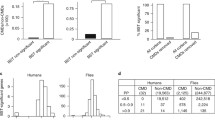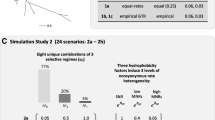Abstract
Inferring positive selection at single amino acid sites is of particular importance for studying evolutionary mechanisms of a protein. For this purpose, Suzuki and Gojobori (1999) developed a method (SG method) for comparing the rates of synonymous and nonsynonymous substitutions at each codon site in a protein-coding nucleotide sequence, using ancestral codons at interior nodes of the phylogenetic tree as inferred by the maximum parsimony method. In the SG method, however, selective neutrality of nucleotide substitutions cannot be tested at codon sites, where only termination codons are inferred at any interior node or the number of equally parsimonious inferences of ancestral codons at all interior nodes exceeds 10,000. Here I present a modified SG method which is free from these problems. Specifically, I use the distance-based Bayesian method for inferring the single most likely ancestral codon from 61 sense codons at each interior node. In the computer simulation and real data analysis, the modified SG method showed a higher overall efficiency of detecting positive selection than the original SG method, particularly at highly polymorphic codon sites. These results indicate that the modified SG method is useful for inferring positive selection at codon sites where neutrality cannot be tested by the original SG method. I also discuss that the p-distance is preferable to the number of synonymous substitutions for inferring the phylogenetic tree in the SG method, and present a maximum likelihood method for detecting positive selection at single amino acid sites, which produced reasonable results in the real data analysis.

Similar content being viewed by others
References
Q-L Choo G Kuo R Ralston AJ Weiner LR Overby DW Bradley M Houghton (1989) ArticleTitleIsolation of a cDNA clone derived from a blood-borne non-A, non-B hepatitis genome Science 244 359–362 Occurrence Handle1:CAS:528:DyaL1MXit1Khtrk%3D Occurrence Handle2523562
AL Erickson Y Kimura S Igarashi J Eichelberger M Houghton J Sidney D McKinney A Sette AL Hughes CM Walker (2001) ArticleTitleThe outcome of hepatitis C virus infection is predicted by escape mutations in epitopes targeted by cytotoxic T lymphocytes Immunity 15 883–895 Occurrence Handle10.1016/S1074-7613(01)00245-X Occurrence Handle1:CAS:528:DC%2BD38Xhsl2ltg%3D%3D Occurrence Handle11754811
WM Fitch (1971) ArticleTitleToward defining the course of evolution: minimum change for a specific tree topology Syst Zool 20 406–416
N Goldman Z Yang (1994) ArticleTitleA codon-based model of nucleotide substitution for protein-coding DNA sequences Mol Biol Evol 11 725–736 Occurrence Handle1:CAS:528:DyaK2cXmt1eit70%3D Occurrence Handle7968486
NH Gruner TJ Gerlach M-C Jung HM Diepolder CA Schirren WW Schraut R Hoffmann R Zachoval T Santantonio M Cucchiarini A Cerny GR Pape (2000) ArticleTitleAssociation of hepatitis C virus-specific CD8+ T cells with viral clearance in acute hepatitis C J Infect Dis 181 1528–1536 Occurrence Handle10.1086/315450 Occurrence Handle1:CAS:528:DC%2BD3cXktlGht7c%3D Occurrence Handle10823750
JA Hartigan (1973) ArticleTitleMinimum mutation fits to a given tree Biometrics 29 53–65
M Hijikata N Kato Y Ootsuyama M Nakagawa S Ohkoshi K Shimotohno (1991) ArticleTitleHypervariable regions in the putative glycoprotein of hepatitis C virus Biochem Biophys Res Commun 175 220–228 Occurrence Handle1:CAS:528:DyaK3MXhtlKqtb0%3D Occurrence Handle1847805
AL Hughes M Nei (1988) ArticleTitlePattern of nucleotide substitution at major histocompatibility complex class I loci reveals overdominant selection Nature 335 167–170 Occurrence Handle10.1038/335167a0 Occurrence Handle1:CAS:528:DyaL1cXlvVCktrY%3D Occurrence Handle3412472
AL Hughes M Nei (1989) ArticleTitleNucleotide substitution at major histocompatibility complex class II loci: evidence for overdominant selection Proc Natl Acad Sci USA 86 958–962 Occurrence Handle1:CAS:528:DyaL1MXhsV2jsbs%3D Occurrence Handle2492668
TH Jukes CR Cantor (1969) Evolution of protein molecules HN Munro (Eds) Mammalian protein metabolism Academic Press New York 21–32
N Kato S Ohkoshi K Shimotohno (1989) ArticleTitleJapanese isolates of the non-A, non-B hepatitis viral genome show sequence variations from the original isolate in the USA Proc Jpn Acad 65 219–223 Occurrence Handle1:CAS:528:DyaK3cXkvFKnsA%3D%3D
N Kato M Hijikata Y Ootsuyama M Nakagawa S Ohkoshi T Sugimura K Shimotohno (1990) ArticleTitleMolecular cloning of the human hepatitis C virus genome from Japanese patients with non-A, non-B hepatitis Proc Natl Acad Sci USA 87 9524–9528 Occurrence Handle1:CAS:528:DyaK3MXisVWnu74%3D Occurrence Handle2175903
M Kimura (1980) ArticleTitleA simple method for estimating evolutionary rates of base substitutions through comparative studies of nucleotide sequences J Mol Evol 16 111–120 Occurrence Handle1:CAS:528:DyaL3MXmtFSktg%3D%3D Occurrence Handle7463489
M Lechmann HG Ihlenfeldt I Braunschweiger G Giers G Jung B Matz R Kaiser T Sauerbruch U Spengler (1996) ArticleTitleT- and B-cell responses to different hepatitis C virus antigens in patients with chronic hepatitis C infection and in healthy anti-hepatitis C virus-positive blood donors without viremia Hepatology 24 790–795 Occurrence Handle10.1053/jhep.1996.v24.pm0008855177 Occurrence Handle1:CAS:528:DyaK28XmvFOisb8%3D Occurrence Handle8855177
SV Muse BS Gaut (1994) ArticleTitleA likelihood approach for comparing synonymous and nonsynonymous nucleotide substitution rates, with application to the chloroplast genome Mol Biol Evol 11 715–724 Occurrence Handle1:CAS:528:DyaK2cXlvFOjsL8%3D Occurrence Handle7968485
M Nei T Gojobori (1986) ArticleTitleSimple methods for estimating the numbers of synonymous and nonsynonymous substitutions Mol Biol Evol 3 418–426 Occurrence Handle1:CAS:528:DyaL28Xmt1aisbs%3D Occurrence Handle3444411
M Nei S Kumar (2000) Molecular evolution and phylogenetics Oxford University Press Oxford
M Nei S Kumar K Takahashi (1998) ArticleTitleThe optimization principle in phylogenetic analysis tends to give incorrect topologies when the number of nucleotides or amino acids used is small Proc Natl Acad Sci USA 95 12390–12397 Occurrence Handle10.1073/pnas.95.21.12390 Occurrence Handle1:CAS:528:DyaK1cXmsl2rurg%3D Occurrence Handle9770497
B Robertson G Myers C Howard T Brettin J Bukh B Gaschen T Gojobori G Maertens M Mizokami O Nainan S Netesov K Nishioka T Shin-i P Simmonds D Smith L Stuyver A Weiner (1998) ArticleTitleClassification, nomenclature, and database development for hepatitis C virus (HCV) and related viruses: proposals for standardization Arch Virol 143 2493–2503 Occurrence Handle10.1007/s007050050479 Occurrence Handle1:CAS:528:DyaK1MXhslaiu7c%3D Occurrence Handle9930205
N Saitou M Nei (1987) ArticleTitleThe neighbor-joining method: A new method for reconstructing phylogenetic trees Mol Biol Evol 4 406–425 Occurrence Handle1:STN:280:BieC1cbgtVY%3D Occurrence Handle3447015
C Su VK Nguyen M Nei (2002) ArticleTitleAdaptive evolution of variable region genes encoding an unusual type of immunoglobulin in camelids Mol Biol Evol 19 205–215 Occurrence Handle1:CAS:528:DC%2BD38XitFSns7o%3D Occurrence Handle11861879
Suzuki Y (1999) Molecular evolution of pathogenic viruses. Doctoral dissertation, Department of Genetics, School of Life Science, Graduate University for Advanced Studies, Hayama, Japan
Y Suzuki T Gojobori (1999) ArticleTitleA method for detecting positive selection at single amino acid sites Mol Biol Evol 16 1315–1328 Occurrence Handle1:CAS:528:DyaK1MXms1Ojt70%3D Occurrence Handle10563013
Y Suzuki T Gojobori (2001) ArticleTitlePositively selected amino acid sites in the entire coding region of hepatitis C virus subtype 1b Gene 276 83–87 Occurrence Handle10.1016/S0378-1119(01)00640-0 Occurrence Handle1:CAS:528:DC%2BD3MXntlKmu7w%3D Occurrence Handle11591474
Y Suzuki M Nei (2001) ArticleTitleReliabilities of parsimony-based and likelihood-based methods for detecting positive selection at single amino acid sites Mol Biol Evol 18 2179–2185 Occurrence Handle1:CAS:528:DC%2BD3MXptFCrs7g%3D Occurrence Handle11719567
Y Suzuki M Nei (2002) ArticleTitleSimulation study of the reliability and robustness of the statistical methods for detecting positive selection at single amino acid sites Mol Biol Evol 19 1865–1869 Occurrence Handle1:CAS:528:DC%2BD38XovFOntLk%3D Occurrence Handle12411595
Y Suzuki T Gojobori M Nei (2001) ArticleTitleADAPTSITE: Detecting natural selection at single amino acid sites Bioinformatics 17 660–661 Occurrence Handle10.1093/bioinformatics/17.7.660 Occurrence Handle1:CAS:528:DC%2BD3MXmtleltL8%3D Occurrence Handle11448887
K Takahashi M Nei (2000) ArticleTitleEfficiencies of fast algorithms of phylogenetic inference under the criteria of maximum parsimony, minimum evolution, and maximum likelihood when a large number of sequences are used Mol Biol Evol 17 1251–1258 Occurrence Handle1:CAS:528:DC%2BD3cXlvFCgs74%3D Occurrence Handle10908645
JD Thompson DG Higgins TJ Gibson (1994) ArticleTitleCLUSTAL W: Improving the sensitivity of progressive multiple sequence alignment through sequence weighting, position-specific gap penalties and weight matrix choice Nucleic Acids Res 22 4673–4680 Occurrence Handle1:CAS:528:DyaK2MXitlSgu74%3D Occurrence Handle7984417
AJ Weiner MJ Brauer J Rosenblatt KH Richman J Tung K Crawford F Bonino G Saracco Q-L Choo M Houghton JH Han (1991) ArticleTitleVariable and hypervariable domains are found in the regions of HCV corresponding to the flavivirus envelope and NS1 proteins and the pestivirus envelope glycoproteins Virology 180 842–848 Occurrence Handle10.1016/0042-6822(91)90104-J Occurrence Handle1:CAS:528:DyaK3MXhtFGqtrw%3D Occurrence Handle1846505
AJ Weiner HM Geysen C Christopherson JE Hall TJ Mason G Saracco F Bonino K Crawford CD Marion KA Crawford M Brunetto PJ Barr T Miyamura J McHutchinson M Houghton (1992) ArticleTitleEvidence for immune selection of hepatitis C virus (HCV) putative envelope glycoprotein variants: potential role in chronic HCV infections Proc Natl Acad Sci USA 89 3468–3472 Occurrence Handle1:CAS:528:DyaK38XktVGlurw%3D Occurrence Handle1314389
Z Yang R Nielsen N Goldman AM Pedersen (2000) ArticleTitleCodon-substitution models for heterogeneous selection pressure at amino acid sites Genetics 155 431–449 Occurrence Handle1:CAS:528:DC%2BD3cXjslKhtb4%3D Occurrence Handle10790415
J Zhang (1999) ArticleTitlePerformances of likelihood ratio tests of evolutionary hypotheses under inadequate substitution models Mol Biol Evol 16 868–875 Occurrence Handle1:CAS:528:DyaK1MXjslGiurw%3D Occurrence Handle10368963
J Zhang M Nei (1997) ArticleTitleAccuracies of ancestral amino acid sequences inferred by the parsimony, likelihood, and distance methods J Mol Evol 44 S139–S146 Occurrence Handle1:CAS:528:DyaK2sXhsFKjsLY%3D Occurrence Handle9071022
J Zhang HF Rosenberg M Nei (1998) ArticleTitlePositive Darwinian selection after gene duplication in primate ribonuclease genes Proc Natl Acad Sci USA 95 3708–3713 Occurrence Handle10.1073/pnas.95.7.3708 Occurrence Handle1:CAS:528:DyaK1cXitlKjtrc%3D Occurrence Handle9520431
A Zibert W Kraas H Meisel G Jung M Roggendorf (1997) ArticleTitleEpitope mapping of antibodies directed against hypervariable region 1 in acute self-limiting and chronic infections due to hepatitis C virus J Virol 71 4123–4127 Occurrence Handle1:CAS:528:DyaK2sXisFWnsbw%3D Occurrence Handle9094694
A Zibert W Kraas RS Ross H Meisel S Lechner G Jung M Roggendorf (1999) ArticleTitleImmunodominant B-cell domains of hepatitis C virus envelope proteins E1 and E2 identified during early and late time points of infection J Hepatol 30 177–184 Occurrence Handle10.1016/S0168-8278(99)80059-2 Occurrence Handle1:CAS:528:DyaK1MXht12qtrY%3D Occurrence Handle10068093
Acknowledgments
The author thanks Masatoshi Nei for his valuable suggestions and comments. This work was supported by National Institutes of Health Grant GM20293 to Masatoshi Nei.
Author information
Authors and Affiliations
Corresponding author
Rights and permissions
About this article
Cite this article
Suzuki, Y. New Methods for Detecting Positive Selection at Single Amino Acid Sites. J Mol Evol 59, 11–19 (2004). https://doi.org/10.1007/s00239-004-2599-6
Received:
Accepted:
Issue Date:
DOI: https://doi.org/10.1007/s00239-004-2599-6




